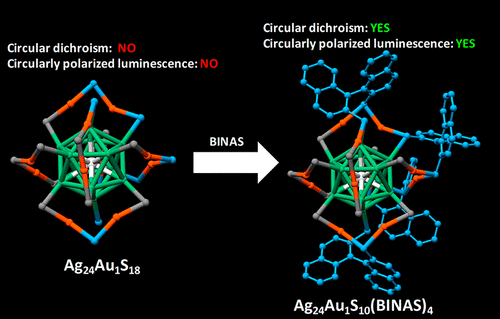Publications
-
Chiral Functionalization of an Atomically Precise Noble Metal Cluster: Insights into the Origin of Chirality and Photoluminescence
Kumaranchira Krishnadas, Luca Sementa, Marco Medves, Alessandro Fortunelli, Mauro Stener, Alexandre Fürstenberg, Giovanna Longhi, and Thomas Bürgi
ACS Nano 2020, 14(8), 9687-9700
 |
We probe the origin of photoluminescence of an atomically precise noble metal cluster, Ag24Au1(DMBT)18 (DMBT = 2,4-dimethylbenzenethiolate), and the origin of chirality in its chirally functionalized derivatives, Ag24Au1(R/S-BINAS)x(DMBT)18–2x, with x = 1–7 (R/S-BINAS = R/S-1,1′-[binaphthalene]-2,2′-dithiol), using chiroptical spectroscopic measurements and density functional theory (DFT) calculations. Combination of chiroptical and luminescence spectroscopies to understand the nature of electronic transitions has not been applied to such molecule-like metal clusters. In order to impart chirality to the achiral Ag24Au1(DMBT)18 cluster, the chiral ligand, R/S-BINAS, was incorporated into it. A series of clusters, Ag24Au1(R/S-BINAS)x(DMBT)18–2x, with x = 1–7, were synthesized. We demonstrate that the low-energy electronic transitions undergo an unexpected achiral to chiral and back to achiral transition from pure Ag24Au1(DMBT)18 to Ag24Au1(R/S-BINAS)x(DMBT)18–2x, by increasing the number of BINAS ligands. The UV/vis, luminescence, circular dichroism, and circularly polarized luminescence spectroscopic measurements, in conjunction with DFT calculations, suggest that the photoluminescence in Ag24Au1(DMBT)18 and its chirally functionalized derivatives originates from the transitions involving the whole Ag24Au1S18 framework and not merely from the icosahedral Ag12Au1 core. These results suggest that the chiroptical signatures and photoluminescence in these cluster systems cannot be solely attributed to any one of the structural components, that is, the metal core or the protecting metal–ligand oligomeric units, but rather to their interaction and that the ligand shell plays a crucial role. Our work demonstrates that chiroptical spectroscopic techniques such as circular dichroism and circularly polarized luminescence represent useful tools to understand the nature of electronic transitions in ligand-protected metal clusters and that this approach can be utilized for gaining deeper insights into the structure–property relationships of the electronic transitions of such molecule-like clusters.
Archive ouverte / Open archive: unige:
